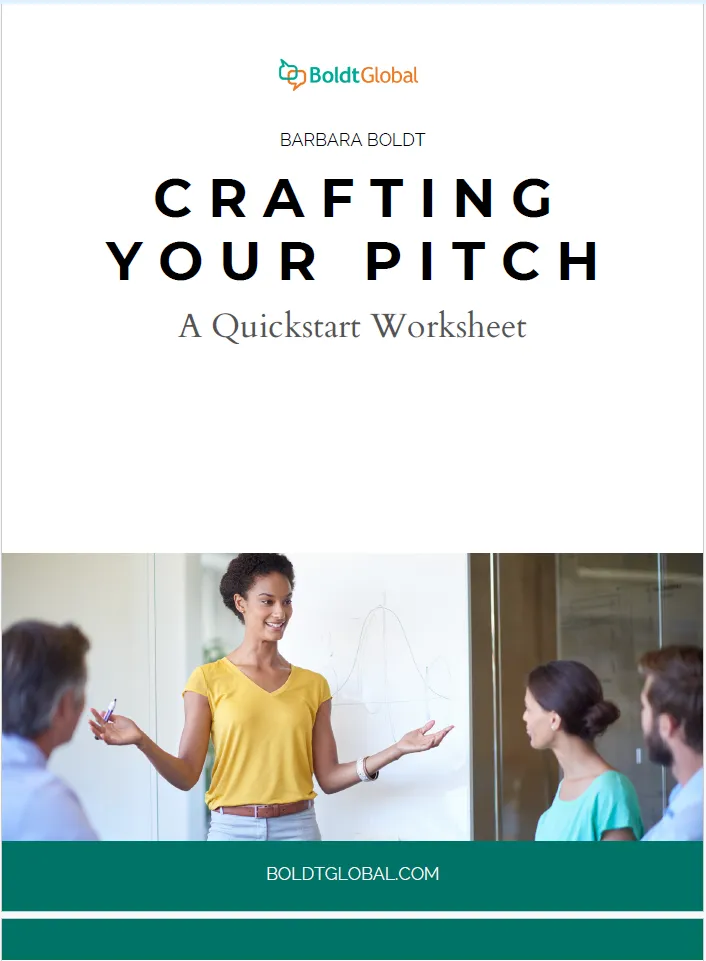Speak with Confidence.
Lead with Impact.
Overcome public speaking anxiety and master executive presence with expert communication coaching
tailored for introverted leaders, executives, and professionals.
Get the "Craft Your Pitch" Worksheet
The "Craft Your Pitch" Worksheet gives you a simple, step-by-step guide to craft a clear, persuasive pitch that connects with your audience and motivates them to take action.
It’s perfect for professionals who need to persuade their team members or upper management to support their initiatives.
Download it now and start building a pitch that helps you get the support you need.
Feel Like Something’s Off In How You Communicate? Barbara Can Help.
Is Fear of Public Speaking or
Unclear Communication Limiting Your Impact?
You know your work inside and out. You have insights that could move projects forward, influence decisions, and elevate your career. But when it’s time to speak up in meetings, present ideas, or lead conversations, you freeze up or don't get the response you are looking for.
Fear of speaking is keeping you silent: Your heart races. Your mind goes blank. You search for the words that slip away. Whether in meetings or important conversations, you find yourself expressing less than you intended, or maybe saying nothing at all.
Your message isn’t landing. When you speak, your message gets lost in translation. Complex ideas confuse rather than convince your audience. Instead of a bridge, your words are a barrier to understanding.
You’re not getting the promotions or recognition you deserve. Colleagues with less expertise but more communication confidence capture the spotlight, getting noticed and advancing, while your talent and knowledge stay hidden behind a wall of fear and hesitation - and you stay stuck in your career rut.
If people don’t understand what you mean, they won’t act. And if they don’t perceive you as a confident communicator, they won’t see you as a leader.
You’ve done the work. Now, it's time for your communication skills to match your capabilities.
Let us help you unlock the influence you deserve.
You Need a Proven Plan to Help You Communicate with Confidence
For over two decades, Barbara Boldt has helped introverted and non-native English speaking managers and leaders overcome their fear, find their authentic voice and command any room with confidence.
Drawing from her twenty-plus years living abroad and working with people from 35+ countries, she brings a unique perspective to leadership communication coaching.
Barbara specializes in transforming hesitant communicators into influential leaders through proven strategies that build executive presence, clear messaging, and natural confidence.
Her approach isn't about changing who you are—it's about empowering you to communicate with impact while staying true to yourself.
Whether you struggle with public speaking anxiety, clarity, or need to enhance your leadership presence, Barbara provides the tools and support to help you speak with clarity and lead with presence.
Barbara's Coaching Combines:

Strategic Communication Training - Learn how to craft clear, persuasive messages and deliver them with impact.

Nervousness & Anxiety Reduction – Discover practical techniques (like EFT tapping) and targeted exercises to ease public speaking fears.

Real-World Speaking & Leadership Communication Practice – Build confidence and skill using real business scenarios, from preparing for crucial meetings to making persuasive presentations.
With the right tools, you can stop feeling anxious and start speaking with confidence.
A Proven Path to Speaking with Confidence
Schedule a Free Discovery Call – Let’s identify your biggest communication challenges.
Receive a Customized Communication Plan – Receive tailored coaching to refine your communication style and leadership communication.
Speak with Confidence & Influence – Enter every meeting, presentation, and leadership conversation with a presence that draws people in and inspires action.
Start Communicating and Leading with Confidence!
When You Don't Improve Your Communication Skills You Risk:
🔴Missed Career Opportunities – Promotions, leadership roles, and recognition pass you by.
🔴Diminished Credibility – Your expertise gets overshadowed by stronger communicators.
🔴Continued Speaking Anxiety – Every meeting, pitch, or presentation feels stressful instead of empowering.
Our Client Reviews
"I was losing the audience and I didn’t know why. I wasn’t getting the right help. I didn’t know exactly what I was looking for until I met Barbara. Now I am more confident. I can be myself. I’m not faking it anymore."

Laura Ciornohaci
Interior Project Chief at Stellantis
"Working with Barbara has been a game-changer. "

Annamarie Conti
PhD Professor of Economics
"After working with Barbara, I see and feel major improvements in the way I communicate. She is kind and supportive and goes the extra mile. I cannot recommend Barbara enough!"

Alessandra Agnello
Learn Essential Skills to Elevate Your
Verbal Communication

Formal Presentations

Elevator Pitches


Informal Conversations
Frequently Asked Questions
Q: What services do you offer?
I provide customized communication coaching tailored to your specific goals.
Here’s how it works:
Identify Core Issues: We delve into your unique situation to pinpoint your communication challenges.
Set Achievable Goals: Together, we establish clear goals and criteria for success.
Develop and Practice: We create and refine materials relevant to your role and use targeted exercises to enhance your delivery.
Receive Actionable Feedback: You get direct, honest feedback to help you make impactful behavioral changes. Ongoing Support: I hold you accountable and support you every step of the way, cheering you on as you achieve your communication goals.
Q: Who are your typical clients?
I work with leaders, managers, and professionals who are introverted and aiming to advance their careers. My clients are skilled in their fields but often find persuasive communication challenging. I help them develop the ability to influence others, secure resources, and gain support for their ideas, empowering them to become more effective leaders and communicators.
Q: What makes your approach unique?
My approach to communication coaching is unique because I focus on clearly identifying and addressing your specific challenges. With extensive experience working with clients from diverse backgrounds, including non-native English speakers, I've developed a keen ability to pinpoint exactly what needs to be improved. This allows me to tailor my coaching to your individual needs, ensuring that you craft clear, persuasive messages and enhance your overall communication skills. Whether you’re facing challenges with clarity, persuasion, or any other aspect of communication, I’m here to help you overcome them effectively.
Q: Do you offer online or remote services?
Yes, I offer both online and remote coaching services to accommodate your needs. Additionally, I provide hybrid coaching options that combine virtual sessions with in-person meetings, allowing for flexible and personalized support tailored to your schedule and preferences. Whether you prefer to work from the comfort of your home or need a mix of both remote and in-person interactions, I’m here to help you achieve your communication goals.
Q: What results can I expect?
While I don’t offer guarantees, you can expect a personalized and immersive coaching experience. I dive deep into your industry to fully understand your communication challenges, ensuring our sessions are relevant and tailored to your needs. Through detailed feedback on your presentations, tailored exercises, and ongoing support, my goal is to help you develop effective communication skills that enhance your impact and achieve the recognition you deserve. Results may vary depending on your commitment, the specific challenges you face, and how you apply the strategies we work on together.
Q: How long does the process take?
The duration of the coaching process varies depending on your specific needs and goals. Typically, coaching sessions are held weekly over a period of three months. However, the exact timeline is tailored to fit your individual requirements and the complexity of your communication challenges. We will discuss and establish a schedule that aligns with your objectives during our initial consultation.
Q: How much do your services cost?
Pricing details are discussed after our initial discovery call. This call helps me understand your unique communication needs and allows me to tailor a coaching plan specifically for you. Following the call, I’ll provide a customized proposal outlining the costs and structure of the coaching program. If you have any questions about pricing or want to get started, please schedule a discovery call to explore how we can work together.
Q: Do you offer a guarantee?
While I strive to deliver impactful and personalized coaching tailored to your specific needs, results may vary depending on individual effort, goals, and commitment. My approach involves deeply understanding your unique challenges and working closely with you to achieve your communication objectives. Although I do not offer a guarantee, I am dedicated to providing you with the tools and feedback needed to help you improve and succeed in your communication endeavors.
Q: How do I get started?
To get started, schedule a 30-minute discovery call. During this call, I’ll delve into your communication needs and challenges through a series of questions to understand your situation better. This conversation helps us determine if my coaching is a good fit for you. I'll also explain how my one-on-one coaching works, typically involving weekly sessions over approximately three months. Pricing will be discussed later; if you're interested, I'll create a proposal for us to review in a follow-up discussion.
Q: How can I contact you for more information?
For more information, please reach out to me at [email protected]. I’m happy to answer any questions you have and discuss how my coaching services can support your communication goals.

Boost Your Communication Skills by Getting Weekly Tips! Join Our Newsletter!
Have Questions or Comments?
Please reach out. I'd love to hear from you!
Call 810.877.2818
Email: [email protected]



